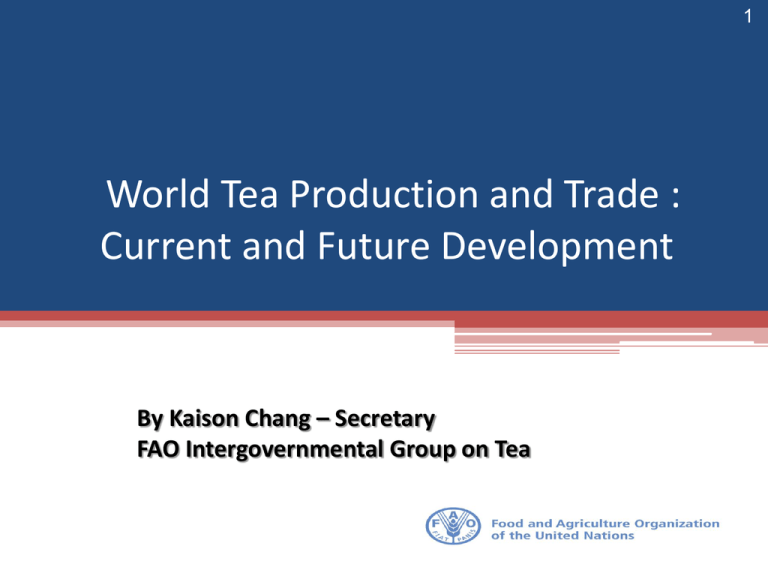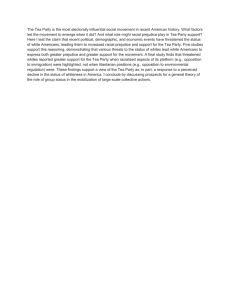World Tea Production and Trade : Current and Future Development
advertisement

1 World Tea Production and Trade : Current and Future Development By Kaison Chang – Secretary FAO Intergovernmental Group on Tea 2 Introduction • Current market situation and outlook to 2023; • Response to questionnaires by member countries, supplemented by other sources; • Macro-economic data from the IMF, World Bank and OECD. 3 INTRODUCTION • Grateful to Argentina, India, Indonesia, Kenya, Malawi, Sri Lanka, United Republic of Tanzania, and Vietnam; • Cooperation promotes: ▫ Improving market transparency; ▫ Fostering market expansion; and ▫ Value chain enhancement. • Delegates to review the information presented in document CCP: TE 14/Inf. 3 with its annexed tables 1 to 9, and amend and supplement these where necessary, with updates pertaining to their countries. 4 World Production of Tea, 2009-2013 6000 thousand tonnes 5000 4000 3000 2000 1000 0 2009 2010 TOTAL TEA 2011 BLACK TEA 2012 GREEN TEA 2013 5 World Exports of Tea, 2009-2013 1800 thousand tonnes 1750 1700 1650 1600 1550 1500 1450 1400 2009 2010 2011 2012 2013 6 World Consumption of Tea, 2009-2013 5000 4500 4000 thousand tonnes 3500 3000 2500 2000 1500 1000 500 0 2009 2010 2011 2012 2013 7 8 Actual and Projected Black Tea Production (thousand tonnes) 4500 4000 3500 3000 2500 2000 1500 1000 500 0 2013 2023 9 Actual and Projected Green Tea Production (thousand tonnes) 3500 3000 2500 2000 1500 1000 500 0 2013 2023 10 Actual and Projected Black Tea Consumption (thousand tonnes) 4500 4000 3500 3000 2500 2000 1500 1000 500 0 2013 2023 11 Actual and Projected Black Tea Exports (thousand tonnes) 1600 1400 1200 1000 800 600 400 200 0 2013 2023 12 Actual and Projected Green Tea Exports (thousand tonnes) 700 600 500 400 300 200 100 0 2013 2023 13 Concluding Remarks – Production and Exports • Tea trade increased 5%: earnings by 10% to USD 5.7 billion; • Contribution to food import bill: ▫ Kenya at USD 1.3 billion > 50% ▫ Sri Lanka at USD 1.55 billion = 71%. • Others : ▫ Indonesia = USD 155 million; Tanzania =USD 61.4 million. • Trickle down effects to rural incomes and household food security were invaluable. 14 Concluding Remarks – cont’d • Weaker Composite Price, mostly due to CTC auction prices, and if there is no correction, this downward trend will continue; • Growth in demand is in green and specialist tea segments; • In the medium term, the projections suggest that supply and demand of black tea will be in equilibrium in 2023 at a nominal price of USD 2.81 per Kg. Real price will be lower. 15 FAO Tea Prices USD/Kg Baseline Projections 3.5 3 2.5 2 1.5 1 0.5 nominal prices real prices 2023 2022 2021 2020 2019 2018 2017 2016 2015 2014 2013 2012 2011 2010 2009 2008 2007 2006 2005 0 16 Concluding Remarks – cont’d • However, if there is no correction in supplies and assume that output increases a further 5 percent, the impact on prices would be quite dramatic; • A 40 percent decline over the next 10 years reaching USD 1.82 per Kg in 2023 or an average of USD 1.60 for the decade. 17 3.5 FAO Tea Prices USD/kg 5 percent increase in World Production 3 2.5 2 1.5 1 Base Prices Simulation prices 0.5 2023 2022 2021 2020 2019 2018 2017 2016 2015 2014 2013 2012 2011 2010 2009 2008 2007 2006 2005 0 18 Concluding Remarks – cont’d • However, if the reaction to the declining prices were to cut back on production, say by 5 percent less than the baseline, then prices could be 27 percent higher for the decade reaching USD 3.4 per Kg in 2023 . 19 FAO Tea Prices USD/kg 5 percent decline in World Production 4.5 4 3.5 3 2.5 2 1.5 Base Prices 1 Simulation prices 0.5 2023 2022 2021 2020 2019 2018 2017 2016 2015 2014 2013 2012 2011 2010 2009 2008 2007 2006 2005 0 20 Conclusions • Caution needs to be exercised; • Greater efforts should be directed at expanding demand, particularly in producing countries with relatively low per capita tea consumption and relatively strong economic growth, as consumption is already high in traditional markets; • Diversification into other segments of the market such as organic tea should also be encouraged and the health benefits of tea consumption should be used more extensively in promoting consumption in both producing and importing countries. However, in targeting potential growth markets, recognition of and compliance with food safety and quality standards is essential. 21 Thank You!



